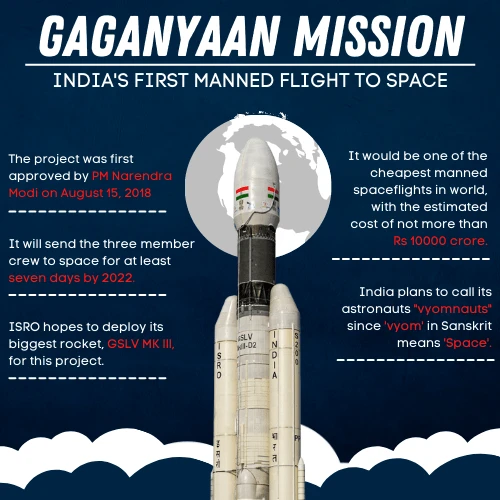Gaganyaan: Parachutes For Re-Entry
Context:
Indian Space Research Organisation (ISRO) facility in Bengaluru started testing for locally produced parachutes for the safe return of the astronaut-carrying spacecraft which is scheduled to happen in the month of June.
Gaganyaan Programme
-
- The Indian Space Research Organisation (ISRO) is creating the crewed spacecraft called Gaganyaan.

- A second uncrewed test flight and the first crewed flight are scheduled for 2024, 2023, and 2023, respectively.
- India will follow the United States, China, and the Soviet Union (later Russia) as the fourth country to launch a crewed spacecraft.
- The crew module (CM) and service module (SM), which together make up the orbital module, are the two components that make up the Gaganyaan spacecraft.
- Up to three astronauts can travel in the CM, which has the shape of a truncated cone.
- During launch, the SM lies under the CM and houses the craft’s propulsion and power components. The CM will split off from the SM upon reentry and splash into the water.
- The Human Rated Launch Vehicle (HRLV), a variant of India’s most potent rocket, the Launch Vehicle Mark III (LVM3), modified for crewed spaceflight, will carry Gaganyaan into space at the Satish Dhawan Space Centre in Sriharikota.
- In 2012, work on the Indian crewed spacecraft began. During the LVM3’s initial flight in December 2014, it successfully splashed down in the Bay of Bengal after carrying a CM mockup on a suborbital trajectory.
- Four Indian Air Force pilots who were chosen for the programme and trained at ISRO’s astronaut training centre in Bengaluru and Russia.
- Originally scheduled for 2022, the first crewed flight has been delayed as a result of the global coronavirus epidemic.
- Vyommitra, a humanoid robot with female features that can communicate with ground controllers and read instrument panels within the spaceship, will be aboard the second unmanned test mission.
- The first crewed flight will carry three astronauts who will spend up to a week in low Earth orbit.
Points to Ponder:
- The Gaganyaan programme, which aims to launch a crew of three astronauts into low-Earth orbit, is India’s first human spaceflight effort.
- The Indian Space Research Organisation (ISRO) is leading the programme, which is scheduled to begin in 2023.
- The program’s main goals are to excite young people, show off India’s aptitude for human spaceflight, and advance technology, infrastructure, and industry in the nation.
- The astronauts’ transportation system, the crew module, is being created and developed by ISRO. The Geosynchronous Satellite Launch Vehicle (GSLV) Mark III rocket carrying it will be used to launch it into space.
- The program’s parachutes were created by the Aerial Delivery Research and Development Establishment (ADRDE), a lab within the Defence Research and Development Organisation (DRDO).
- The crew module will be safely returned to Earth using the ten parachutes that make up the system.
- The parachute design consists of three “pilot parachute” systems that will separately deploy three “main parachutes” to slow the crew module’s speed upon landing, along with two “apex cover separation parachutes,” two “drogue parachute deployment” parachutes, and two “pilot parachute” parachutes.
- The parachutes will undergo fitment tests in July 2023, and the first unmanned flight won’t launch until two successful tests have been completed.
- Complex testing procedures must be used to assess each parachute’s performance, and each parachute has already completed testing at the sub-system level.
- The Gaganyaan program’s success will represent a significant turning point for India’s space programme and may open the door for additional human spaceflight missions, including those to the Moon and beyond.




